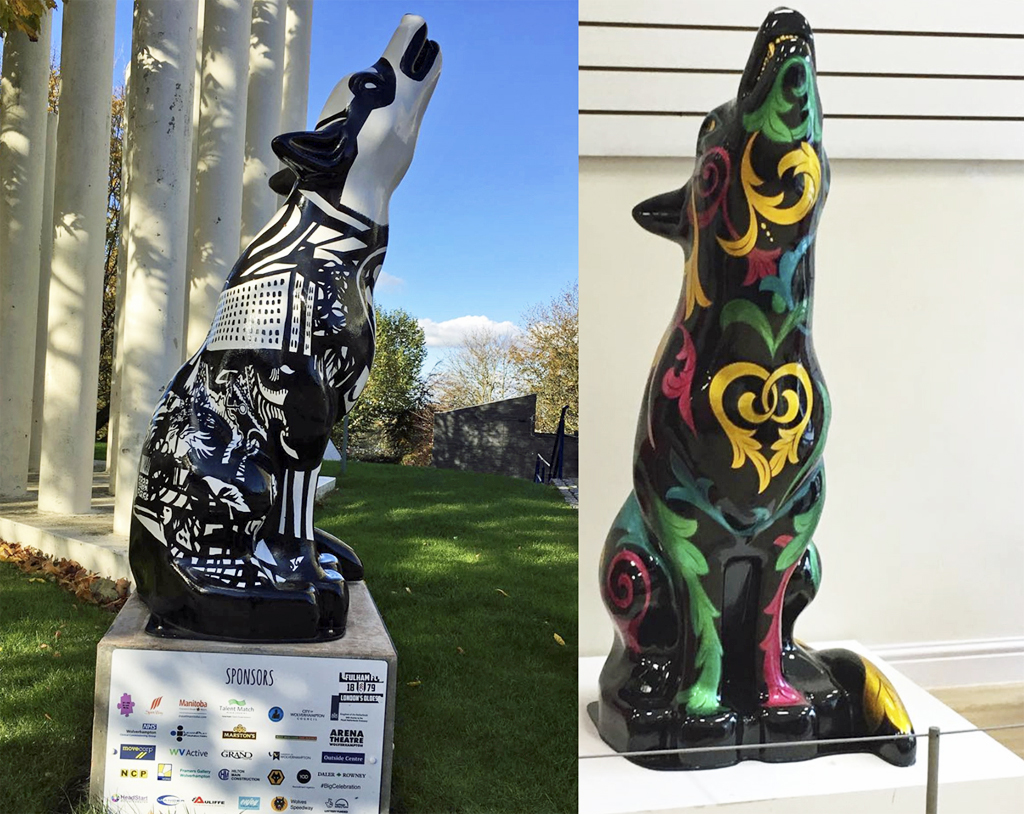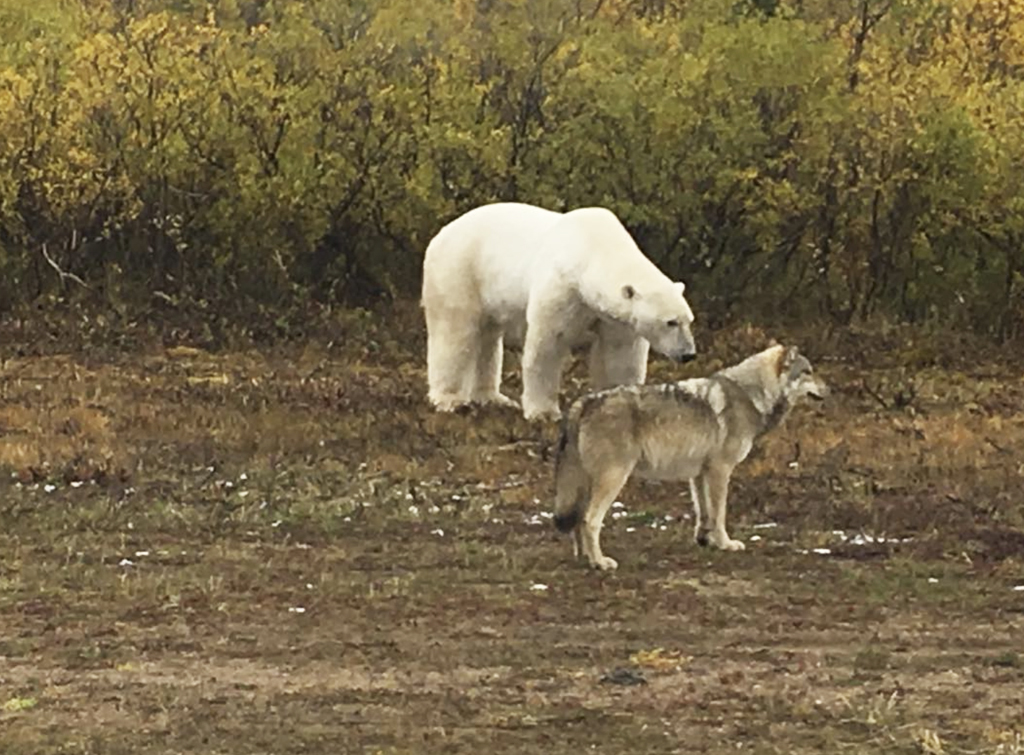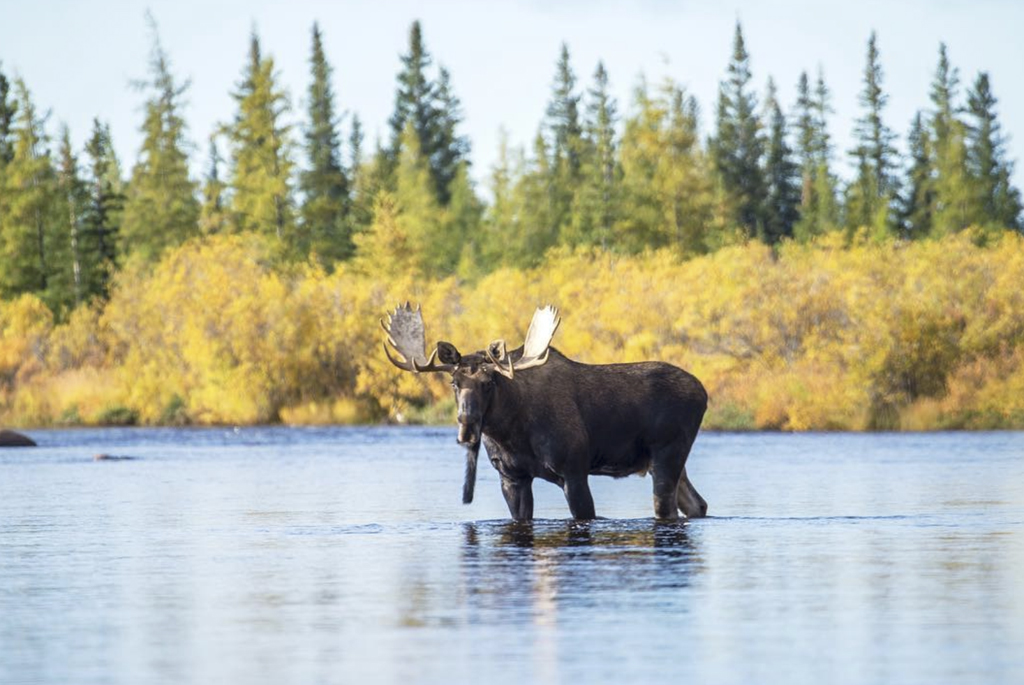
Contest winner Natasha George and partner Fred Richings “keeping quiet while waiting for a moose” at Nanuk.
Natasha George won a trip for two to Nanuk Polar Bear Lodge in 2017, but it wasn’t the polar bears and wolves that impressed her most when she arrived at the lodge in the fall of 2018, it was the beauty and clean air.
The 51-year-old fundraising consultant from Wolverhampton, UK, won the grand prize in a contest sponsored by Travel Manitoba and Spirit Way Inc. of Thompson, Manitoba, that was also a joint venture between the sister cities of Thompson and Wolverhampton, with wolves as the connection.
Natasha’s vacation prize was a 12-day trip for two from London, England to Manitoba, Canada to see polar bears, wolves, wilderness and more, and it included a visit to the award-winning Spirit Way trail in Thompson and a 4-day stay at Nanuk Polar Bear Lodge.
“It was a once-in-a-lifetime holiday,” said Natasha. “Mostly because it was the sort of holiday I would not normally look for or would have chosen. It would never have occurred to me. I’m not against wildlife, but my trips are generally related to arts and culture. That actually made it better, as I almost didn’t have any expectations. Now that I’ve done it, I can see how amazing it is. It was so brilliant. It exceeded any expectations I might have had. Please pass on my thanks to everyone who promoted the prize. It really was excellent.”

Wolves in Wolves. Spirit Way wolf on left. Wolverhampton wolf on right.
The contest celebrated Canada’s 150th Birthday and was designed to promote Thompson as The Wolf Capital of the World. It also featured the placement of 30 large fiberglass wolf statues in Wolverhampton as part of a “Wolves in Wolves” promotion. A small group of Canadians including an indigenous artist traveled to Wolverhampton to paint two of the wolves, one of which was later displayed in Charing Cross Station in London as part of the contest entry process.
Wolverhampton does not have any actual wolves, but their popular Wolverhampton Wanderers football team uses a wolf as its logo, hence the connection. Thompson, on the other hand, has wolves in the boreal forest that surrounds it.
Most recently, in their continuing quest to develop Thompson as a tourism destination, Spirit Way project co-ordinator Volker Beckmann announced a fundraising goal of $1 million over the next 18 months to develop a Wolf Centre of Excellence by 2020, which will promote best practices for human and wolf coexistence through education, ecotourism, science and research.
Natasha’s stay at Nanuk Polar Bear Lodge was the highlight of her trip, but the contest prize also featured visits to Winnipeg, Thompson and Churchill to see world-class attractions that included Assiniboine Park Zoo’s Journey to Churchill polar bear exhibit; the Canadian Museum for Human Rights, the first museum of its kind in the world; the spectacular Pisew Falls and Paint Lake Provincial Park; the Spirit Way pathway and biking route that highlights 16 unique points of interest, wolf statues, and the world’s largest lighted mural of a Robert Bateman painting in Thompson; and North America’s oldest, still-standing, one-time military fortress, the Prince of Wales Fort in Churchill.
After touring Churchill, Natasha and her partner Fred Richings boarded a small plane bound for Nanuk Polar Bear Lodge, which is located deep in the heart of polar bear country on Canada’s historic Hudson Bay coast. A member of the prestigious National Geographic Unique Lodges of the World collection, Nanuk Polar Bear Lodge is 40 km east of York Factory, where the first explorers came to Canada in the 1600s, and it remains one of the wildest, most pristine places on the planet.
“It’s a different world,” said Natasha. “It’s like a bubble, but a lovely bubble. The main thing that struck me about Nanuk was the cleanliness of the air and the beautiful views. I almost enjoyed the scenery and the birds and the sky as much or more than the animals. It was such a unique experience to be in that landscape and breathe that clean air.”
Natasha’s group at Nanuk included guests from Australia, China, Hong Kong, Switzerland and the UK, and before venturing out to see polar bears they were all given the required safety talk by the guides.
“It was quite funny at the beginning,” said Natasha. “We got the safety talk, and they took us through all the different procedures and deterrents, the body language of polar bears, making a loud noise, noise makers, bangers, screamers and clacking stones together. And the latter did work when a curious cub came toward us. It was nerve-wracking, fulfilling and exciting, all at the same time. We tell people about the safety briefing, about clacking a few stones together, and they look at us like we’re crazy. But I actually did feel quite reassured.”
Natasha had high praise for the group’s guides, Terry Elliot, Andy MacPherson, Kevin Brightnose and Albert ‘Butch’ Saunders. “They were really amazing,” she said. “Very professional but also so friendly and knowledgeable. The evening lectures were interesting and very well delivered. It really was fantastic.”
On their excursions, the group was treated to polar bears, black bears, wolves, birds, a variety of smaller creatures and a moose called in by Saunders, who used a traditional moose call combined with the waving of a paddle with a gardening glove on it. “It worked!” said Natasha. “I really enjoyed watching that. A majestic moose emerged from the bush on the banks of the river and crossed slowly right in front of us. It was wonderful.”
“We also saw quite a few polar bears,” said Natasha. “Some at the lodge and some that we walked out to see, including a mother and her cub. We had no problem at all with the walking. It was a bit stretching in places, but the guides were careful to take into account the age and capabilities of the group. On another occasion there was a polar bear on the runway with wolves. We saw lots of wolves. Black and tawny. So beautiful. And quite a few black bears too, including mothers and cubs.”
Of course, we had to ask Natasha about the food. Was it different from what she and Fred were used to in the UK?
“Amazing food and service,” said Natasha. “Absolutely fantastic. Fred thought he’d died and gone to heaven. All home cooked and lovely people serving it. Really friendly and professional. I haven’t got a single negative thing to say about the lodge. I’ve already recommended it to friends. I have several who do like quality and I have suggested they might enjoy this trip. I can’t stress highly enough how much we enjoyed it.”
The beauty of Nanuk was something that especially resonated with Natasha, who chooses her fundraising projects based both on their merits and their picturesque surroundings. One of her most recent projects was applying for a grant from the Heritage Lottery Fund, for the historic Ffestiniog and Welsh Highland Railways in Wales.
“It’s another place where the scenery really gets to me,” said Natasha. “I always take jobs where the scenery speaks to me. It’s stunningly beautiful. The railways are a tourist attraction now, and I was raising money to train 20 people in heritage skills. It’s a place that adds beauty to the world.
“People from Canada should consider visiting the railways if they’re in Wales. It’s only one of the projects I work on in terms of beauty and relative isolation, but it’s a good comparison. Nanuk is 100% more isolated, but North Wales is considered isolated in UK terms. You can go walking in the Snowdonia Mountains and there are beautiful beaches and coastline. Bits of Wales are under-looked and absolutely stunning.”
Scenic beauty has always been a major component of top travel destinations, and it’s one of the main reasons why North Wales was named one of Lonely Planet’s Best in Travel Top Regions for 2017. It’s also why Manitoba was selected to be part of Lonely Planet’s Best in Travel Top Regions for 2019.
We added the polar bears, wolves, and crisp, clean air.
For Natasha.










